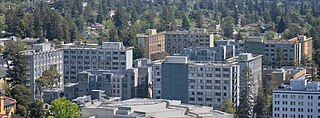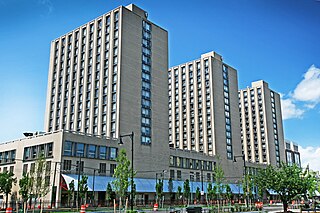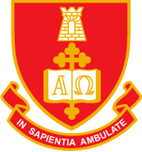
An apartment, flat, or unit is a self-contained housing unit that occupies part of a building, generally on a single story. There are many names for these overall buildings. The housing tenure of apartments also varies considerably, from large-scale public housing, to owner occupancy within what is legally a condominium or leasehold, to tenants renting from a private landlord.

Carlton is an inner-city suburb in Melbourne, Victoria, Australia, three kilometres north of the Melbourne central business district within the City of Melbourne local government area. Carlton recorded a population of 16,055 at the 2021 census.

St Mary’s College is a constituent college of Durham University. It is located mainly on Elvet Hill to the South of the city centre, becoming the first of Durham’s “hill colleges”. Following the grant of a supplemental charter in 1895 allowing women to receive degrees of the university, St Mary's was founded as a women’s only college called the Women’s Hostel in 1899, adopting its present name in May 1920. It enjoys a reputation as one of the most attractive colleges of Durham because of its neoclassical architecture and picturesque landscape.

East Melbourne is an inner-city suburb in Melbourne, Victoria, Australia, 2 km (1.2 mi) east of Melbourne's Central Business District, located within the City of Melbourne local government area. East Melbourne recorded a population of 4,896 at the 2021 census.

St Mark's College is an Australian university co-residential college in North Adelaide, South Australia. Founded in 1925, it is affiliated with the Anglican Church of Australia. It is the oldest residential college in South Australia and is associated with the University of Adelaide, the University of South Australia and Flinders University. Located next to St Peter's Cathedral on Pennington Terrace, the college houses 245 tertiary students in both dormitory and apartment accommodation.

Housing at the University of California, Berkeley, includes student housing facilities run by the office of Residential and Student Service Programs (RSSP). Housing is also offered by off-campus entities such as fraternities and sororities and the Berkeley Student Cooperative (BSC).

The Boston University housing system is the 2nd-largest of any private university in the United States, with 76% of the undergraduate population living on campus. On-campus housing at BU is an unusually diverse melange, ranging from individual 19th-century brownstone town houses and apartment buildings acquired by the school to large-scale high-rises built in the 60s and 2000s.

The campus housing system at the University of Michigan in Ann Arbor, referred to as University Housing, provides living accommodations for approximately 10,000 undergraduate and graduate students. There is no requirement for first-year students to live in University Housing, yet approximately 97% of incoming students choose to do so. Every year, over 9,500 undergraduate students are housed in 18 residence halls on Central Campus, the Hill Neighborhood, and North Campus. Undergraduates, graduate students, and students with families can live in University Housing apartments in the Northwood Community on North Campus. Seven full-service dining halls as well as several retail shops provide students with daily dining options.

International House is a world renowned and second - largest residential college of the University of Melbourne. Situated at 241 Royal Parade in Parkville, it provides co-educational accommodation to 350 undergraduate and graduate students who are attending the University of Melbourne and nearby tertiary institutions.

North Campus is a mostly residential section of Cornell University's main campus in Ithaca, New York. It includes the neighborhoods located north of Fall Creek. All freshmen are housed on North Campus as part of Cornell's common first-year experience and residential initiatives.

Jane Franklin Hall in Hobart, Australia is an independent non-denominational residential college of the University of Tasmania. Familiarly referred to as "Jane", it was founded by the Tasmanian Council of Churches in 1950 as a residential college for women before becoming co-educational in 1973. Jane is a non-denominational Christian institution supported by chaplains of various Christian traditions and is the only college in the Oxbridge style attached to the university.

Multifamily residential, also known as multidwelling unit (MDU), is a classification of housing where multiple separate housing units for residential inhabitants are contained within one building or several buildings within one complex. Units can be next to each other, or stacked on top of each other. Common forms include apartment building and condominium, where typically the units are owned individually rather than leased from a single building owner. Many intentional communities incorporate multifamily residences, such as in cohousing projects.

Sancta Sophia College is a residential college for undergraduate women and postgraduate men and women at the University of Sydney. The college has a Catholic foundation but admits students of all religions. Fiona Hastings has been the principal of the college since 2018.

Student housing owned by the University of California, Los Angeles is governed by two separate departments: the Office of Residential Life, and Housing and Hospitality Services, and provides housing for both undergraduates and graduate students, on and off-campus.

Housing at the University of Chicago includes seven residence halls that are divided into 48 houses. Each house has an average of 70 students. Freshmen and sophomores must live on-campus. Limited on-campus housing is available to juniors and seniors. The university operates 28 apartment buildings near campus for graduate students.
Stony Brook University is the largest residential campus in the State University of New York system, with approximately 54.5% of its students living on campus. Housing at Stony Brook is issued and controlled by Stony Brook University Campus Residences, which provides 9,445 spaces in its 11 corridor style buildings, 19 suite style buildings, and 23 apartment style buildings to Undergraduate students, Graduate students, and students' families. The large majority of on-campus housing is provided to students on the university's west campus, but housing is available to those on east campus, and for Stony Brook Southampton students.

A microapartment, also known as a microflat, micro-condo, or micro-unit is a one-room, self-contained living space, usually purpose built, designed to accommodate a sitting space, sleeping space, bathroom and kitchenette with 14–32 square metres.
Suzanne Dance is a Melbourne-based architect who has spent over four decades focusing on architectural conservation and residential work in the inner suburbs of Melbourne. She has been a resident of Fitzroy since 1975 and for eight years she was secretary of the Historic Buildings Sub-Committee of Fitzroy Council's Urban Conservation Advisory Committee.

The Internationale Begegnungszentrum der Wissenschaft is a residential building for both international scientists at the Free University of Berlin and the Max Planck Society and fellows of the Alexander von Humboldt Foundation. It is located at the Wiesbadener Straße in Berlin Wilmersdorf. The IBZ Berlin is a founding member of the Network of the Internationale Begegnungszentren der Wissenschaft, an association of international guesthouses (IBZs) and university-related guesthouses in Germany. The 25 million Marks used to fund the IBZ, have been generously provided by the Alexander von Humboldt Foundation, the Volkswagen Foundation and the Land Berlin. Between 2010 and 2011 the building was renovated with the financial support of the Federal Ministry of Education and Research, and the Alexander von Humboldt Foundation.

The Women's College building is the heritage-listed building of The Women's College. a residential college for women students at the University of Sydney, located at 15 Carillon Avenue, Newtown, City of Sydney, New South Wales, Australia. It was designed by architects Sulman & Power and built from 1892 to 1924, with Bignell and Clark responsible for the initial construction. It was added to the New South Wales State Heritage Register on 1 April 2005.





















